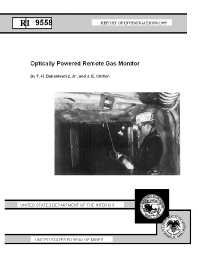Mining Publication: Optically Powered Remote Gas Monitor
Original creation date: January 1995
Many mines rely on toxic gas sensors to help maintain a safe and healthy work environment. This report describes a prototype monitoring system developed by the U.S. Bureau of Mines (USBM) that uses light to power and communicate with several remote toxic gas sensors. The design is based on state-of-the-art optical-to-electrical power converters, solid-state diode lasers, and fiber optics. This design overcomes several problems associated with conventional wire-based systems by providing complete electrical isolation between the remote sensors and the central monitor. The prototype performed well during a 2-week field trial in the USBM Pittsburgh Research Center Safety Research Coal Mine.
Authors: TH Dubaniewicz, JE Chilton
Report of Investigations - January 1995
NIOSHTIC2 Number: 20024778
U.S. Department of the Interior, Bureau of Mines, Report of Investigations 9558, NTIS stock number: PB95-236808, 1995 Jan; :1-8
See Also
- Hybrid Fiber-Optic Electrochemical Carbon Monoxide Monitor
- Lasers
- Methane-Air Mixtures Ignited by CW Laser-Heated Targets on Optical Fiber Tips: Comparison of Targets, Optical Fibers, and Ignition Delays
- The Modified Direct Method: A Solution for Obtaining Accurate Coal Desorption Measurements
- Preliminary Performance Predictions For Electromagnetic Through-The-Earth Mine Communications: A Collection of Working Memoranda
- Rapid (Grab) Sampling During Full-scale Explosions - Microscopic and Analytical Evaluation
- Remote Fiber-Optic Methane Monitor
- Remote Gob Gas Venthole Monitoring and Cellular Telephone-Based Real-Time Data Transmission System
- Strategies to Reduce Miners Exposure to DPM and Gases (Elko)
- Strategies to Reduce Miners Exposure to DPM and Gases (Reno)
- Threshold Powers and Delays for Igniting Propane and Butane-Air Mixtures by CW Laser-heated Small Particles
- Content source: National Institute for Occupational Safety and Health, Mining Program


 ShareCompartir
ShareCompartir
